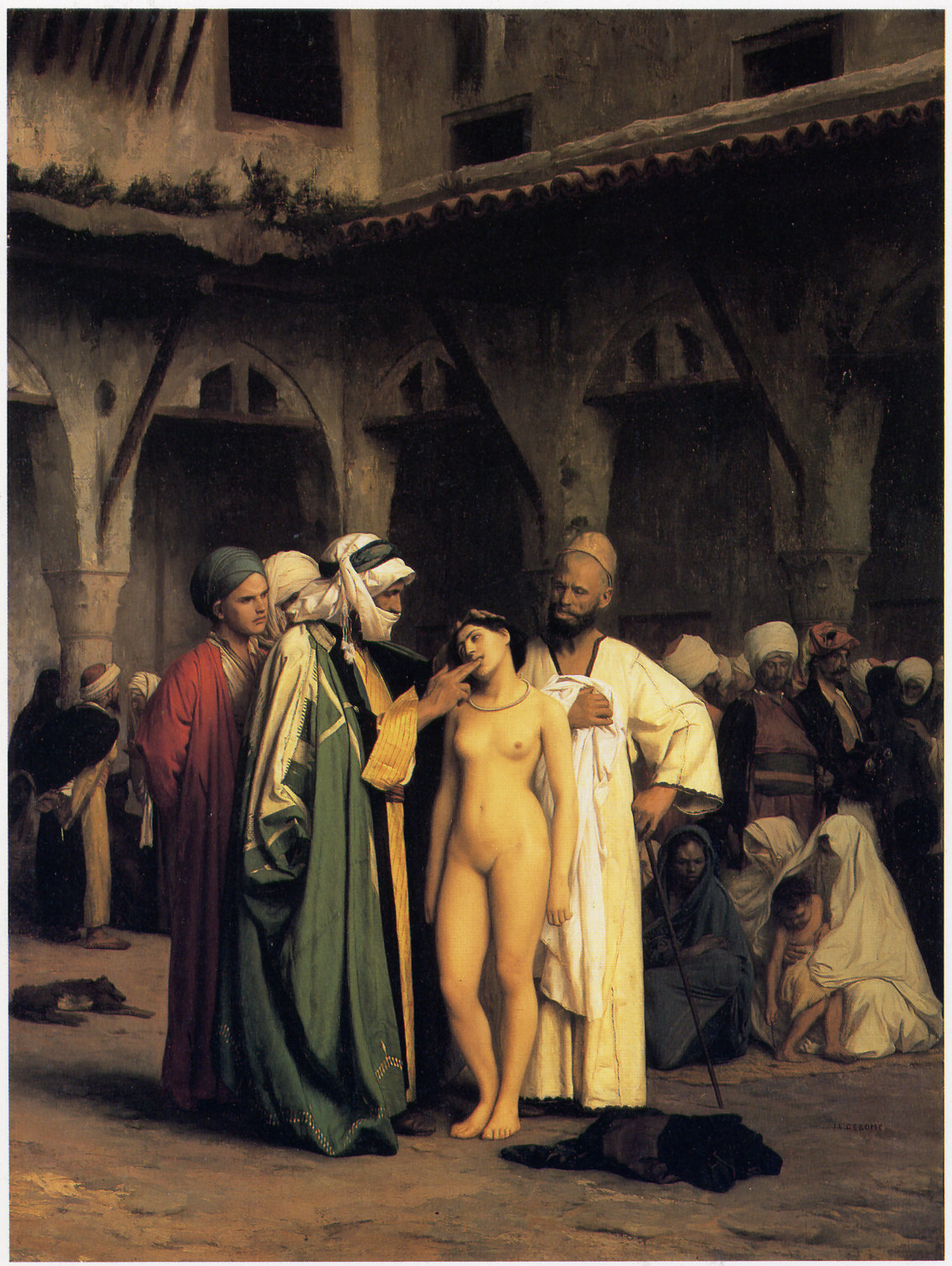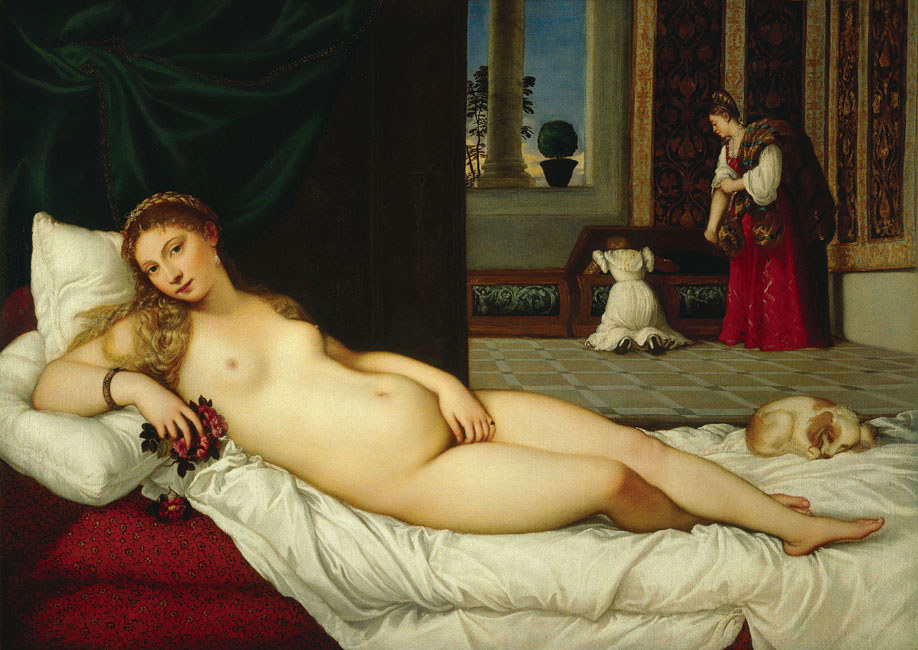 |
|
Velezquez, The Rokeby Venus 1647-51 |
|
Gauguin, Spirit of the Dead Keep Watch, 1892
Photo from |
 |
|
Gerome, The Slave Market 1866
Photo from http://fr.wikipedia.org/wiki/Fichier:G%C3%A9r%C3%B4me_Jean-L%C3%A9on_The_Slave_Market.jpg |
 |
|
Boucher, Girl Reclining (Louise O’Murphy) 1751
Photo from http://www.francoisboucher.org/Girl-Reclining-(Louise-O'Murphy)-1751.html |
 |
| Titian, Venus of Urbino, 1538 photo from http://smarthistory.khanacademy.org/titians-venus-of-urbino.html |
 |
|
Manet, Olympia 1863 Photo from http://en.wikipedia.org/wiki/Olympia_(Manet) |
To watch a video on the painting 'Manet, Olympia' please click here: http://smarthistory.khanacademy.org/manet-olympia
In the above images we clearly see nudity is a common theme but
once we take a closer look we can see that each painting conveys a slightly
different message. In the Rokeby Venus
we see Velezquez conveys a message of vanity by the use of the mirror. Boucher alludes to a woman’s indecency in his positioning
on the recliner in the ‘Girl Reclining’.
Botticelli, Birth of Venus 1486 captures a female’s
innocence whereas Manet accentuates immorality in the Olympia. Gauguin, Spirit of the Dead Keep Watch, 1892
has a malicious and wicked connotation while Gerome insinuates possession; this
by far was the most disturbing. Gerome’s
choice of a slave market setting coupled with the gesture (man placing his
finger in the woman’s mouth) was degrading.
 |
| Ingres, Grande Odalisque 1814 |
.
 |
| Velezquez, The Rokeby Venus 1647-51 |
Comparing and contrasting the Ingres,
Grande Odalisque 1814 to Velezquez, The Rokeby Venus (1647-51) though at first glance
they appear similar with the image of a nude women on a bed with their backs to
the on looker their representations differ.
Both artist Velezquez and Ingres
add a delicate elegant value to the paintings by the use of contouring lines
aiding in the three dimensional illusion. Ingres, uses light to focus the onlookers attention
to the maiden in La Grande Odalisque as opposed to Velezquez who uses a shadowing to give a darkened hue to the
painting The Rokeby Venuse. The artist use
of colors varies from portrait to portrait.
La Grande Odalisque the color blue of the tapestry constitutes the feeling
of sorrow as it is accentuated by the use of light and beigh coloring of the odalisque
(concubine) skin. Velezquez use of “luminescent
colors in Venus's skin contrast with the dark greys and black of the silk she
is lying” ("Velezquez, The Rokeby Venus
1647-51," n.d., p. 1). The color
red for the tapestry is used to signify love or passion. Velezques use of the “folded bed sheets echo
the goddess's physical form, and are rendered to emphasize the sweeping curves
of her body” ("Velezquez, The Rokeby Venus 1647-51," n.d., p.
1).
“La Grande Odalisque was commissioned
by Queen Caroline Murat of Naples, Napoleon’s sister and created during a time when
harems and concubines were widely accepted” (http://lorenaybe.hubpages.com/hub/La-Grande-Odalisque-an-unusual-woman)
and depicts a concubine. “Ingres created
a cool aloof eroticism accentuated by the use of a peacock fan, turban, pearls
and the hookah, a pipe used for opium” ("La Grande Odalisque ,"
n.d., p. 1).
Velezquez painting the Rokeby Venus depicts
the “Roman goddess of love, beauty and fertility, Venus” ("Velezquez, The Rokeby Venus
1647-51," n.d., p. 1). The
female figure can be identified as Venus because of the presence of her son,
Cupid.("Velezquez, The Rokeby Venus 1647-51," n.d., p. 1). The intertwining pink silk ribbons draped over
the mirror and curling the frame “bond the god to the image of beauty”
("Velezquez, The Rokeby Venus 1647-51," n.d., p. 1). It “has been claimed that the painting
depicts a mistress Velázquez is known to have had while in Italy” ("Velezquez, The Rokeby Venus
1647-51," n.d., p. 1).
The messages from these two paintings
are reflected by the gaze of the women. La
Grande Odalisque looks right at the viewer as if she has a message to convey. .
Initially sensuality and mystery are evoked but upon a closer look into her
gaze one can sense there is no please
but merely a “sense of duty of a concubine” ”(http://lorenaybe.hubpages.com/hub/La-Grande-Odalisque-an-unusual-woman). In contrast the maiden in the Rokeby Venus “looks
outward from her mirror reflection, the “blurred, indistinct vague reflection
of her facial appearance is key to the underlying meaning of the painting, an
image of “self-absorbed beauty" ("Velezquez, The Rokeby Venus
1647-51," n.d., p. 1). Each
image gives us something to consider. La
Grande Odalisque brings out the consideration of physical pleasure, at what
cost to the other individual involved whereas The Rokeby Venus give rise to the
question of love mixed with beauty, it physical beauty enough? Or is beauty to be measured by ones qualities.
References
 |
| Titian, Venus of Urbino, 1538 photo from http://smarthistory.khanacademy.org/titians-venus-of-urbino.html |
 |
| Manet, Olympia 1863 Photo from http://en.wikipedia.org/wiki/Olympia_(Manet) |
In comparing Manet’s
Olympia to Titian’s Venus of Urbino there was a shocking concern with the photo
like representation of Manet’s painting to a “courtesan’ ("Manet, Olympia 1863," n.d.,
p. 1). It was not so much the nudity
of the painting as much as it’s representation of an unspoken profession of prostitution.
The symbols of wealth, sensuality and prostitution are
incorporated with in Manet’s Olympia painting.
Titian’s Venus “dog, which symbolized fidelity was replaced with a
“black cat, a symbol of prostitution” ("Manet, Olympia 1863," n.d.,
p. 1). This was a cold hard reality of
life contrary to Titian’s fictional “Roman goddess of love, beauty and fertility, Venus”
("Velezquez, The Rokeby Venus 1647-51," n.d., p. 1). Olympia association with a high paying
cliental as depicted by the “orchid in her hair, the bracelet, pearl earrings
and even the oriental shawl she lies on” (Manet, Olympia 1863," n.d., p.
1) forcing the onlooker to associate her as a courtesan.
Whereas onlookers always
felt comfortable looking at nude paintings of the fictional Venus they now felt
very uncomfortable with Olympia’s “direct business like gaze” ("Manet, Olympia 1863," n.d.,
p. 1). The viewer was left feeling repulsed
and disturbed by the graphic depiction of her firm grasp in protecting her
genitalia as if ‘emphasizing her independence and sexual dominance over men”
("Manet, Olympia 1863," n.d., p. 1).
So dissimilar to Titian's Venus simple gesture in attempt to cover herself.
Manet managed to challenge the viewers to reconsider what
art was, by painting a prostitute. Art
had always been considered a thing of beauty and yet he had produced a painting of an unspeakable topic. The “almost
photograph image’ ("Manet,
Olympia 1863," n.d., p. 1), with a flatten form and lack of modeling
effect of light and dark colors,almost appeared to be a “cut out image”("Manet, Olympia 1863," n.d., p. 1 ) , this effect in itself would lead the
onlooker to question if it was? Would he dare use such an image that would implicate
that he had or frequently visited such a place? the audacity.
Reference

No comments:
Post a Comment